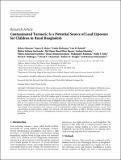| dc.contributor.author | Gleason, Kelsey | en_US |
| dc.contributor.author | Shine, James P. | en_US |
| dc.contributor.author | Shobnam, Nadia | en_US |
| dc.contributor.author | Rokoff, Lisa B. | en_US |
| dc.contributor.author | Suchanda, Hafiza Sultana | en_US |
| dc.contributor.author | Ibne Hasan, Md Omar Sharif | en_US |
| dc.contributor.author | Mostofa, Golam | en_US |
| dc.contributor.author | Amarasiriwardena, Chitra | en_US |
| dc.contributor.author | Quamruzzaman, Quazi | en_US |
| dc.contributor.author | Rahman, Mahmuder | en_US |
| dc.contributor.author | Kile, Molly L. | en_US |
| dc.contributor.author | Bellinger, David C. | en_US |
| dc.contributor.author | Christiani, David C. | en_US |
| dc.contributor.author | Wright, Robert O. | en_US |
| dc.contributor.author | Mazumdar, Maitreyi | en_US |
| dc.date.accessioned | 2014-10-01T14:27:50Z | |
| dc.date.issued | 2014 | en_US |
| dc.identifier.citation | Gleason, K., J. P. Shine, N. Shobnam, L. B. Rokoff, H. S. Suchanda, M. O. S. Ibne Hasan, G. Mostofa, et al. 2014. “Contaminated Turmeric Is a Potential Source of Lead Exposure for Children in Rural Bangladesh.” Journal of Environmental and Public Health 2014 (1): 730636. doi:10.1155/2014/730636. http://dx.doi.org/10.1155/2014/730636. | en |
| dc.identifier.issn | 1687-9805 | en |
| dc.identifier.uri | http://nrs.harvard.edu/urn-3:HUL.InstRepos:12987244 | |
| dc.description.abstract | Background. During the conduct of a cohort study intended to study the associations between mixed metal exposures and child health outcomes, we found that 78% of 309 children aged 20–40 months evaluated in the Munshiganj District of Bangladesh had blood lead concentrations ≥5 µg/dL and 27% had concentrations ≥10 µg/dL. Hypothesis. Environmental sources such as spices (e.g., turmeric, which has already faced recalls in Bangladesh due to high lead levels) may be a potential route of lead exposure. Methods. We conducted visits to the homes of 28 children randomly selected from among high and low blood lead concentration groups. During the visits, we administered a structured questionnaire and obtained soil, dust, rice, and spice samples. We obtained water samples from community water sources, as well as environmental samples from neighborhood businesses. Results. Lead concentrations in many turmeric samples were elevated, with lead concentrations as high as 483 ppm. Analyses showed high bioaccessibility of lead. Conclusions. Contamination of turmeric powder is a potentially important source of lead exposure in this population. | en |
| dc.language.iso | en_US | en |
| dc.publisher | Hindawi Publishing Corporation | en |
| dc.relation.isversionof | doi:10.1155/2014/730636 | en |
| dc.relation.hasversion | http://www.ncbi.nlm.nih.gov/pmc/articles/PMC4158309/pdf/ | en |
| dash.license | LAA | en_US |
| dc.title | Contaminated Turmeric Is a Potential Source of Lead Exposure for Children in Rural Bangladesh | en |
| dc.type | Journal Article | en_US |
| dc.description.version | Version of Record | en |
| dc.relation.journal | Journal of Environmental and Public Health | en |
| dash.depositing.author | Shine, James P. | en_US |
| dc.date.available | 2014-10-01T14:27:50Z | |
| dc.identifier.doi | 10.1155/2014/730636 | * |
| dash.authorsordered | false | |
| dash.contributor.affiliated | Rokoff, Lisa | |
| dash.contributor.affiliated | Shine, James P. | |
| dash.contributor.affiliated | Bellinger, David | |
| dash.contributor.affiliated | Christiani, David | |


